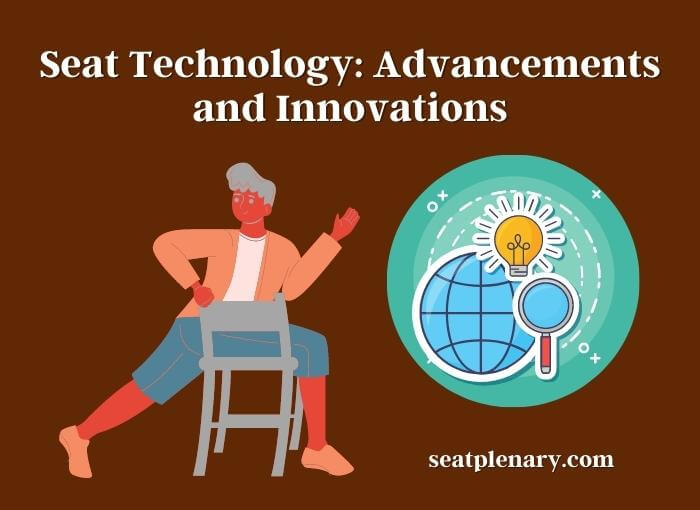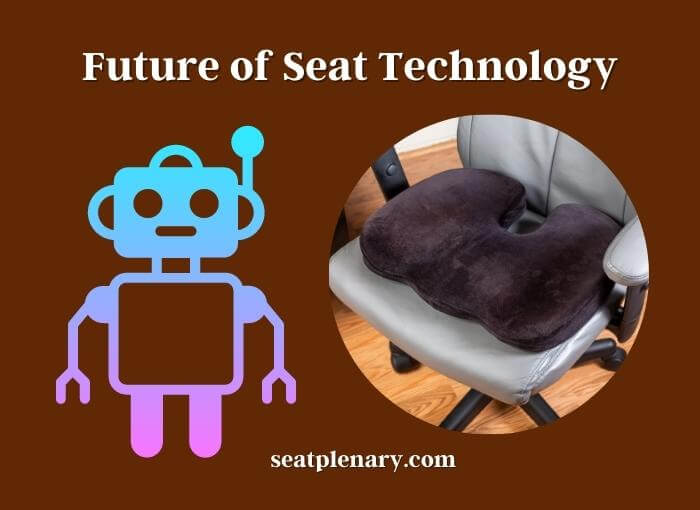Car seats have played a crucial role in the evolution of automobiles. From the early days of vehicles, where car seats were nothing more than flat benches, to the present day, where seats have advanced to become a critical component of the driving experience. Seats now provide not only comfort but also safety and convenience for drivers and passengers alike.

Today, there is a wide range of seat technology available, from basic manual adjustments to advanced features like massage seats, ventilated seats, and memory seats. As the demand for more innovative and convenient car seats has grown, car manufacturers have continuously pushed the boundaries of technology to create seats that meet the expectations of modern drivers and passengers.
Definition of Seat Technology
Seat technology refers to the various technologies and features that are incorporated into the design and construction of seats in vehicles, furniture, and other applications. These technologies can include materials selection, ergonomic design, cushioning and padding, heating and cooling systems, lumbar support, and adjustable headrests, among others.
The purpose of seat technology is to provide comfort, safety, and convenience to users. For example, ergonomic design can help prevent back pain and promote good posture, while heating and cooling systems can provide comfort in extreme temperatures. Adjustable headrests and lumbar support can help reduce the risk of neck and back injuries in the event of an accident.
Seat technology is constantly evolving and improving, with new innovations being developed all the time. Advances in materials science, electronics, and other fields are helping to create seats that are more comfortable, safer, and easier to use than ever before.
History of Seat Technology
The history of seat technology is a long and fascinating one that dates back to ancient times. Throughout history, people have used a variety of materials to create seats for different purposes, from basic wooden benches to plush thrones fit for royalty. Let’s explore some of the major milestones in the development of seat technology.
Ancient Seats
The earliest known seats were simple wooden benches or stools used by the ancient Egyptians, Greeks, and Romans. These basic seats were often used for religious or political events and were not designed for comfort.
Medieval Seats
During the Middle Ages, seats became more ornate and decorative, reflecting the wealth and power of the ruling classes. Thrones and other types of elaborate seating were often made of wood and decorated with gold or precious gems.
17th Century
In the 17th century, chairs began to be designed with ergonomics in mind, with curved backs and seats that conformed to the human body. This made them more comfortable sitting for extended periods of time.
19th Century
The Industrial Revolution brought about significant changes in seat technology, with the introduction of new materials such as cast iron, steel, and molded plastic. These materials allowed for the mass production of chairs and other seating, making them more affordable and accessible to the general public.
20th Century
In the 20th century, seat technology continued to evolve rapidly. In the 1920s, Marcel Breuer designed the first tubular steel chair, which revolutionized modern furniture design. The 1950s saw the introduction of the Eames Lounge Chair, which remains an icon of mid-century modern design to this day. In the latter part of the century, advances in computer technology led to the development of ergonomic office chairs that could be adjusted to fit individual users’ needs.
21st Century
Today, seat technology continues to advance, with a focus on sustainability, comfort, and innovation. Many modern chairs are designed to be both stylish and eco-friendly, using materials such as bamboo, recycled plastic, and organic fabrics. High-tech seats that incorporate features such as massage, heating, and cooling are also becoming more common. In addition to these advancements, synthetic fabric seat benefits include durability, easy maintenance, and a wide range of design options that appeal to various aesthetic preferences. These materials often resist stains and wear, making them ideal for high-use environments. As manufacturers explore new technologies, the integration of smart features, such as built-in sensors and connectivity, is also on the rise, enhancing the overall seating experience.
The history of seat technology is a rich and varied one that spans thousands of years. From basic wooden benches to high-tech massage chairs, seats have evolved to meet the changing needs and preferences of society. As technology continues to advance, it will be important to see what the future of seat design holds.
Types of Seat Technology
When it comes to car seats, there are two main categories of seat technology: basic and advanced. Basic seat technology includes manual and power seat adjustments. Manual seat adjustments are the most basic and involve moving the seat forward or backward, adjusting the seatback angle, and changing the height of the seat cushion. This is done manually by the driver or passenger using a lever or knob.

Power seat adjustments, on the other hand, add more convenience to the process. They have motorized controls that can adjust the seat in various ways, including forward and backward, up and down, and reclining. Power seat adjustments can also include adjustments to the lumbar support, headrest, and even the seat cushion’s tilt angle.
Advanced seat technology, as the name suggests, offers more advanced features than basic seat technology. These features are designed to provide enhanced comfort and convenience to the driver and passengers. Some of the most common advanced seat technology features include:
Memory Seats
Memory seats allow drivers to save their preferred seat position, which can be recalled later. This feature is particularly useful for families where more than one person drives the car.
Heated Seats
Heated seats are equipped with heating elements that provide warmth during colder weather. This feature is particularly useful during winter months.
Ventilated Seats
Ventilated seats provide airflow to the seat cushion, keeping the driver or passenger cool during hot weather.
Massage Seats
Massage seats use a built-in massage mechanism to soothe muscles and relieve fatigue. This feature is particularly useful for long drives.
Adjustable Lumbar Support
Adjustable lumbar support allows drivers and passengers to adjust the lumbar support according to their needs. This feature is particularly useful for people who suffer from back pain.
Active Motion Seats
Active motion seats use sensors to detect the driver’s movements and adjust the seat’s cushion and backrest accordingly. This provides a more comfortable and ergonomic seating position, reducing fatigue during long drives.
Car seats have come a long way from the basic flat benches of the past. Today, there is a wide range of seat technology available, from basic manual adjustments to advanced features like massage seats and active motion seats. These features are designed to provide enhanced comfort and convenience to the driver and passengers, making the driving experience more enjoyable.
Recent Advancements in Seat Technology
Recent advancements in seat technology have focused on improving safety, comfort, and convenience for drivers and passengers. One of the most significant advancements is the integration of sensors and smart technology into car seats.
Smart seats are equipped with sensors that can detect the driver’s vital signs and alert them to any health issues. These sensors can also detect changes in the driver’s posture, which can indicate fatigue or distraction. In such cases, the car’s safety system can alert the driver to take a break or pull over to rest.
Another recent development in seat technology is the use of advanced materials. High-performance materials such as memory foam, gel, and air cushions have been incorporated into car seats to provide better support and comfort. These materials can also help to reduce vibration and noise, making for a smoother ride.
Another significant advancement in seat technology is the development of active safety systems. These systems use sensors and cameras to monitor the driver’s behavior and the surrounding environment, detecting potential hazards and alerting the driver accordingly. Some advanced safety systems can even intervene in critical situations, such as when the driver is about to collide with another vehicle.
One example of an active safety system is the Driver Monitoring System (DMS). The DMS uses cameras and sensors to monitor the driver’s eyes and head movements, detecting when the driver is becoming drowsy or distracted. When the system detects a problem, it can alert the driver to take a break or even activate the car’s safety features, such as automatic emergency braking.
Car seat manufacturers are now focusing on creating seats that are more sustainable and eco-friendly. Some manufacturers are using recycled materials in their seats, while others are using bio-based materials, such as soy foam, to reduce their environmental impact.
Recent advancements in seat technology have focused on improving safety, comfort, and convenience for drivers and passengers. Smart technology, advanced materials, and active safety systems are just some of the recent developments that are changing the way we think about car seats. With the growing demand for more innovative and eco-friendly solutions, the future of car seat technology looks bright.
Future of Seat Technology
The future of seat technology looks promising, as car manufacturers continue to push the boundaries of innovation and creativity. Some of the trends that we can expect to see in the coming years include:

Self-adjusting seats – Car seats that can automatically adjust to the driver’s body shape and preferences are likely to become a reality soon. These seats will use sensors and smart technology to detect the driver’s body shape and adjust the seat accordingly, providing a more comfortable and ergonomic seating position.
Biometric Sensors – Biometric sensors are expected to become more prevalent in car seats in the near future. These sensors will be able to detect the driver’s vital signs, such as heart rate and blood pressure, and provide real-time feedback and alerts in case of any health issues.
Augmented Reality – Augmented reality technology is likely to be incorporated into car seats, providing an immersive experience for passengers. For example, passengers will be able to use their seats as a virtual screen to watch movies or play games.
Eco-Friendly Materials – Car seat manufacturers are expected to continue their focus on eco-friendly materials, using recycled and biodegradable materials to create more sustainable and environmentally friendly seats.
Voice-Activated Controls – Voice-activated controls will become more prevalent in car seats, allowing drivers to control their seat’s features using simple voice commands.
Haptic Feedback – Haptic feedback technology will be used to provide drivers and passengers with a more immersive and tactile experience. For example, the seats could provide feedback when the car is accelerating, braking, or turning.
The future of seat technology is bright, with many exciting developments on the horizon. As car manufacturers continue to innovate and integrate smart technology into their vehicles, we can expect to see more advanced and comfortable car seats in the coming years. With new trends such as self-adjusting seats, biometric sensors augmented reality, and voice-activated controls, the future of car seat technology looks incredibly exciting.
Benefits of Seat Technology
Seat technology offers a range of benefits, including:
Comfort
With ergonomic design, cushioning and padding, and other features, seat technology can provide increased comfort for users, reducing the risk of fatigue, pain, and other discomforts.
Safety
Advanced seat technologies, such as adjustable headrests and lumbar support, can help reduce the risk of neck and back injuries in the event of an accident.
Convenience
Seats with heating and cooling systems, adjustable settings, and other features can provide greater convenience for users, making their experience more enjoyable and efficient.
Durability
Materials selection and construction techniques can help create seats that are more durable and resistant to wear and tear, increasing their lifespan and reducing maintenance and replacement costs.
Health
Certain seat technologies, such as ergonomic design and lumbar support, can help improve overall health by promoting good posture and reducing the risk of chronic pain and other conditions.
Aesthetics
With a wide range of materials, colors, and designs to choose from, seat technology can enhance the aesthetic appeal of a vehicle, furniture, or other application, improving its overall value and appearance.
Frequently Asked Questions (FAQs)
What Is Seat Technology?
Seat Technology refers to the innovative advances and improvements in the design and manufacturing of seating systems. This encompasses various aspects such as comfort, ergonomics, materials used, smart features (like heating, cooling, massaging functions), safety features, and more. Seat technology can be found in different settings, including cars, airplanes, office spaces, and homes.
How Do Split Bench Seats Compare to Advanced Seat Technology in terms of Comfort and Storage?
When it comes to comfort and storage, advanced seat technology offers more benefits compared to split bench seats. Advanced seats typically provide superior comfort with adjustable features and ergonomic design, while also offering integrated storage solutions for added convenience. The split bench seat benefits cannot compete with the advanced technology in these areas.
How Do NRG Racing Seats Compare to Other Advanced Seat Technologies?
NRG Racing Seats are a top choice when comparing fia approved seats to other advanced seat technologies. Their construction and design exceed safety standards, offering advanced protection and support for drivers on the track. With a focus on durability and performance, NRG Racing Seats stand out among the competition.
What Are the Latest Innovations in Handicap Seat Technology at AMC Theatres?
AMC Theatres has made significant strides in purchasing handicap seats, with the latest innovations in technology aimed at improving the movie-going experience for all patrons. These include motorized seating options, enhanced accessibility features, and better placement within the theaters for optimal viewing.
How Do Seat Advancements and Innovations Ensure Safety and Comfort Through Testing and Certification?
Seat advancements and innovations have significantly improved safety and comfort for passengers. Through rigorous testing and certification processes, manufacturers ensure that their seats offer the highest levels of safety and comfort. These advancements are crucial in enhancing the overall travel experience for passengers.
What Advanced Seat Technologies Incorporate Memory Seats and How Do They Enhance Overall Comfort and Convenience?
Advanced seat technologies with memory seats functionality provide the ultimate comfort and convenience by allowing users to save their preferred seating positions. This means the seat will automatically adjust to the saved position, saving time and effort while enhancing the overall comfort of the driving or riding experience.
How Can Seat Technology Incorporate Recycling and Sustainability Practices?
Seat technology can incorporate sustainable seat recycling by using eco-friendly materials in the manufacturing process. Incorporating recycled materials and designing seats for easy disassembly and recycling can reduce waste and promote sustainability in the automotive industry. Embracing sustainable seat recycling practices is crucial for a greener future.
What Are the Latest Innovations in Seat Technology?
As of my knowledge cutoff in 2021, some of the latest innovations in seat technology included adaptive seating (where the seat adjusts based on the user’s body), integrated seat heating and cooling systems, massage functions, smart seats (which can monitor vital signs or alert the user to postural problems), and advanced safety features in automobile seats like whiplash prevention systems. For the most recent advancements, please check the latest resources as technology continues to evolve rapidly.
How Does Adaptive Seating Work in Seat Technology?
Adaptive seating, often seen in advanced vehicle and ergonomic office chairs, utilizes sensors and automated systems to adjust the seat according to the user’s body shape, weight, and preferred position. This is designed to provide optimal comfort and reduce physical stress. Some adaptive seating systems can even remember user preferences, allowing for instant customization when the user sits down.
What Are the Benefits of Advanced Seat Technology in Vehicles?
Advanced seat technology in vehicles provides several benefits. Comfort is significantly enhanced with features like seat heating, cooling, and massaging. Safety is also improved through systems like whiplash prevention, seat belt pre-tensioners, and airbag systems integrated into the seats. Smart seats can also contribute to the health of drivers by monitoring vital signs and alerting drivers when they need to take a break to avoid fatigue.
Is Seat Technology Environmentally Friendly?
The environmental impact of seat technology depends largely on the materials used and the manufacturing process. Some companies are committed to sustainable practices, using recyclable materials and minimizing waste during production. Additionally, technology such as energy-efficient seat heating and cooling can reduce the overall energy usage of a vehicle or building. However, like any product, the production, usage, and disposal of these seating systems do have an environmental footprint.
Verdict
Seat technology has come a long way, and recent advancements and future innovations show no signs of slowing down. With the integration of smart technology, sustainable materials, and safety features, car seats have become more comfortable, safe, and environmentally friendly.
As autonomous vehicle technology advances, car seats will become even more comfortable and personalized, providing a more enjoyable and convenient ride for drivers and passengers. The impact of seat technology on the automotive industry and society will continue to be significant in the years to come.
